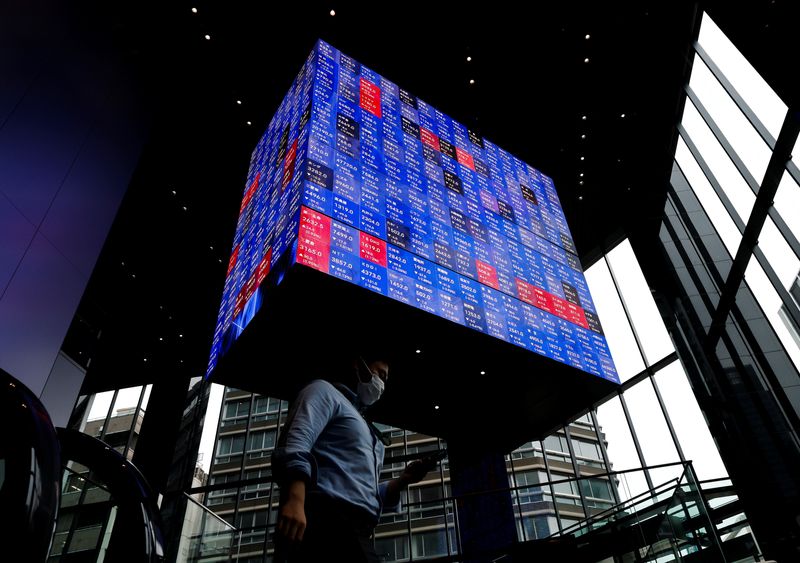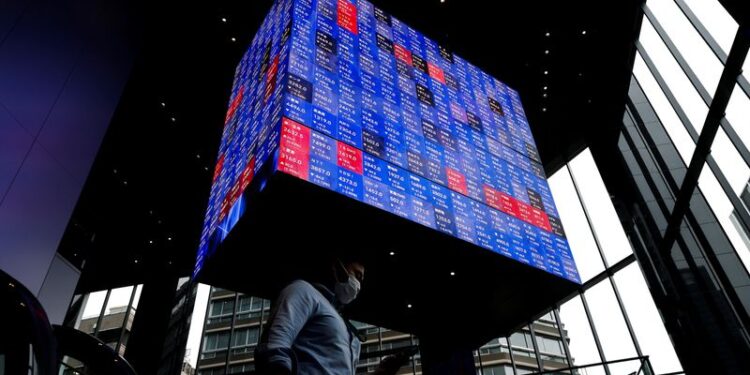By Naomi Rovnick and Rae Wee
LONDON/SINGAPORE (Reuters) -Global stocks rose on Friday and were set for a fourth straight month of gains despite a bout of heavy selling in early August, as bets on U.S. rate cuts also put the dollar on track for its worst month since November.
MSCI’s broad index of global shares edged 0.1% higher on Friday to head for a 1.8% monthly gain while the was set for a more than 2.5% monthly decline after also dropping in July.
That marked a stunning recovery from a turbulent start to August when a slew of weaker-than-expected U.S. economic data and a surprise Bank of Japan rate hike wreaked chaos in currency carry trades and drove an Aug. 5 equity sell-off reminiscent of October 1987’s “Black Monday”.
The next few weeks could be volatile across global markets, however, as investors puzzle over whether U.S. growth is now in fact too strong for the Fed to ease monetary conditions rapidly.
“We’re seeing a bond market that is pricing in a lot of accommodation and an equity market that is reasonably supported by growth,” Pictet Asset Management co-head of multi-asset Shaniel Ramjee said.
Stocks could put in further gains, particularly in cyclical sectors like banks, he said.
But the yield on the 10-year U.S. Treasury, at below 3.9% on Friday after a strong rally in government bond markets, was too low in the face of recent strong data, he added. Bond yields move inversely to prices.
The U.S. economy grew faster than initially thought in the second quarter of this year because of strong consumer spending, and corporate profits, a report on Thursday showed.
The release later on Friday of U.S. core personal consumption expenditures (PCE), the Fed’s favoured inflation measure, also has the potential to shift the rate outlook.
Money markets are confidently pricing the Fed’s first 25 basis point (bp) cut of this cycle at its Sept. 18 meeting, with a 33% chance of a jumbo 50 bp reduction.
That view continued to lift equity markets worldwide on Friday. Europe’s Stoxx index rose 0.2% to a record intraday high in early dealings and 100 hit a three-month high.
U.S. stock futures also pointed to an extension of Wall Street’s positive run, with Nasdaq contracts 0.7% higher and those tracking the up 0.4%.
MSCI’s broadest index of Asia-Pacific shares outside Japan rose 0.7%, set for a 2.2% monthly increase.
, following its early month collapse, was set to lose 1.6% for the month but rose 0.3% on Friday.
DOLLAR WOES
Against the yen, the dollar last stood at 144.79 and was set to lose more than 3% for the month, as pressure eased on the Japanese currency on the prospect of narrowing interest rate differentials.
Core inflation in Japan’s capital Tokyo accelerated for a fourth straight month in August, data showed on Friday, with the 2.4% price increase signalling further BoJ rate hikes ahead.
The euro fell 0.02% to $1.1075, having declined 0.38% in the previous session after lower-than-expected German inflation data added to bets of further European Central Bank (ECB) rate cuts.
Euro zone government bonds were little changed ahead of bloc-wide inflation figures on Friday. The German yield, the benchmark for the euro zone, slipped 0.8 basis points to 2.28% and the interest rate sensitive two-year yield was little changed at 2.36%.

In commodities, futures added 0.7% to $80.51 a barrel, while futures gained 0.8% to $76.54 [O/R]
was steady AT $2,519.86 an ounce, though was set for a 2.7% gain for the month, helped by the weaker dollar. [GOL/]







